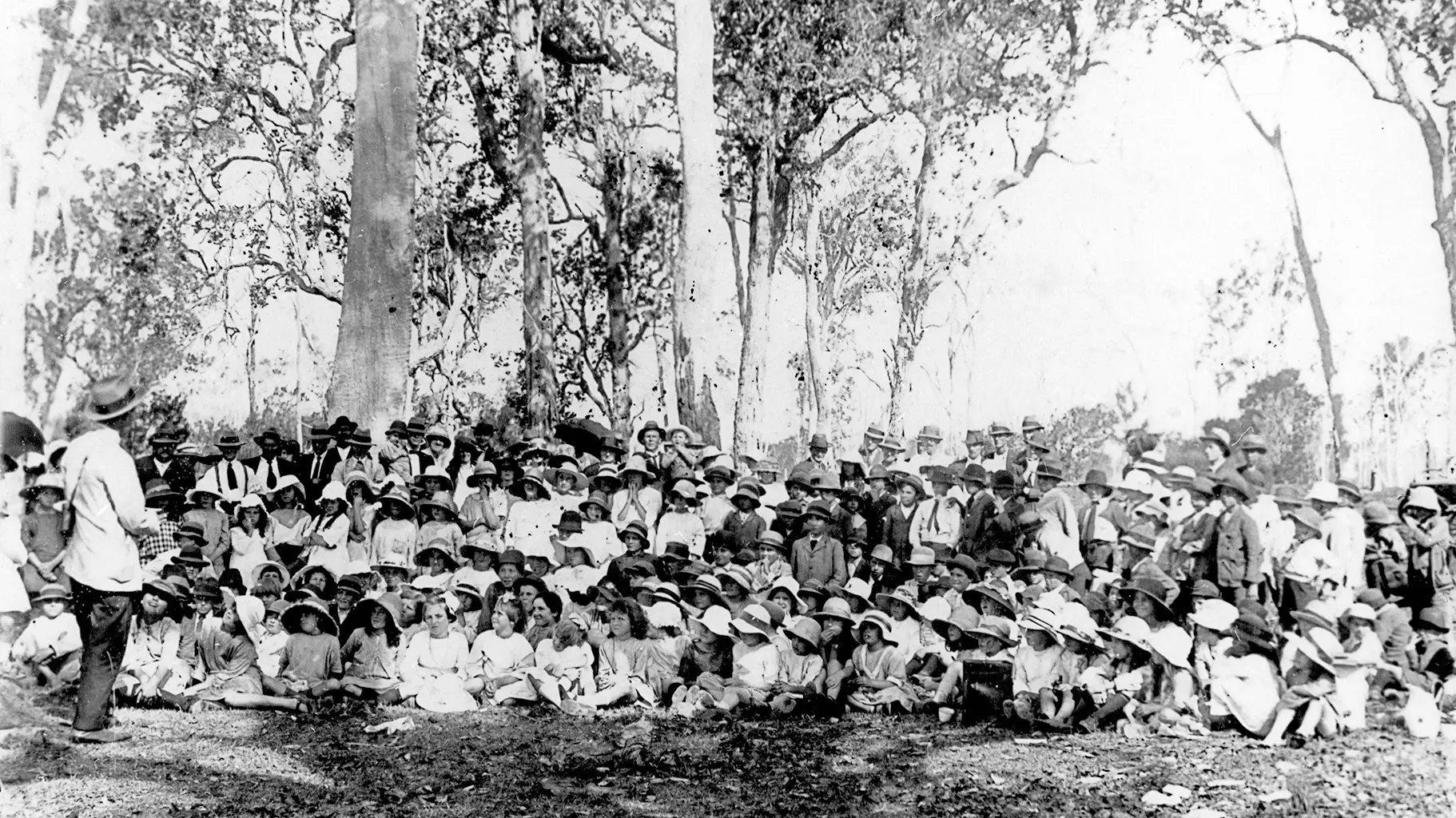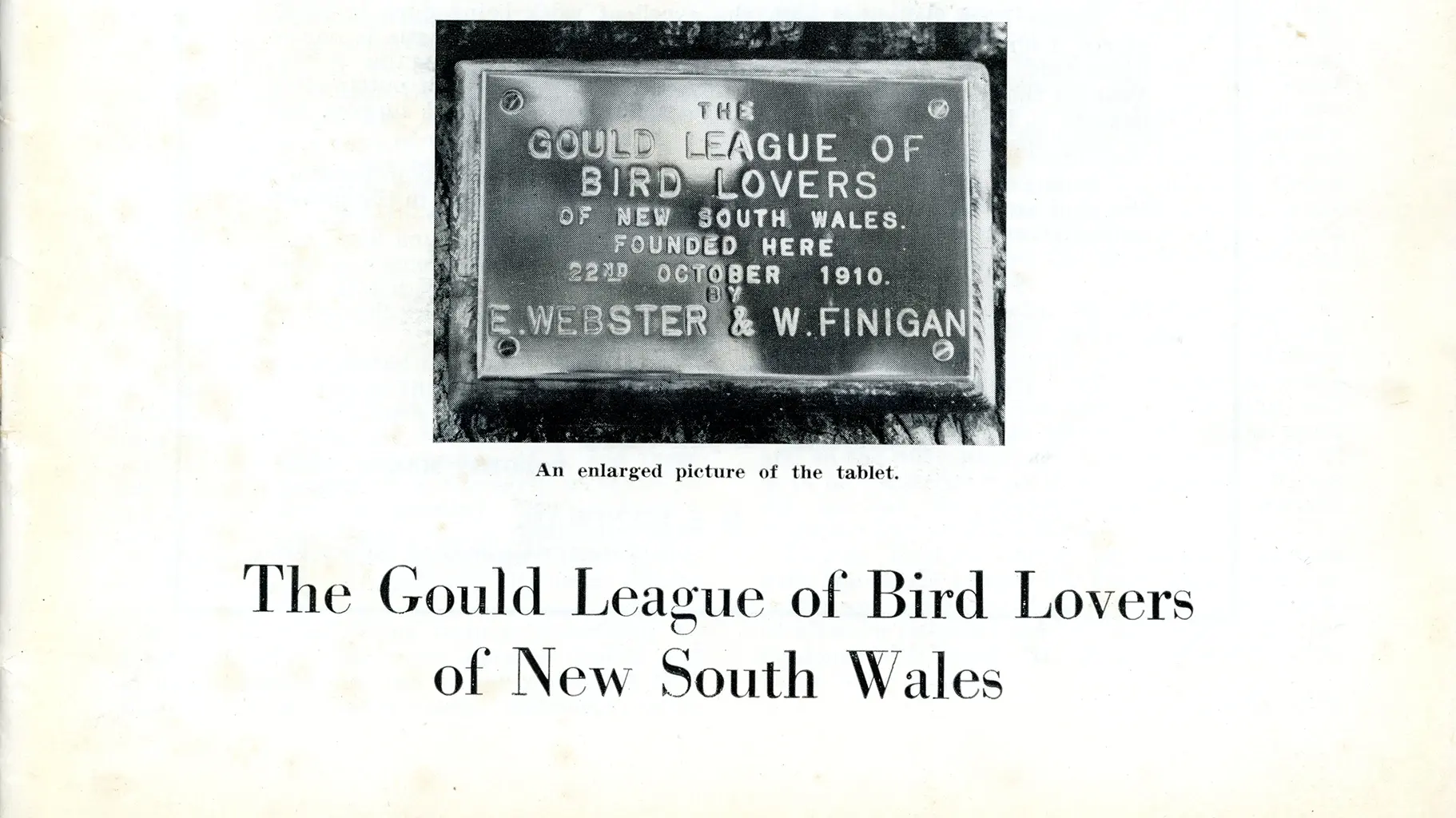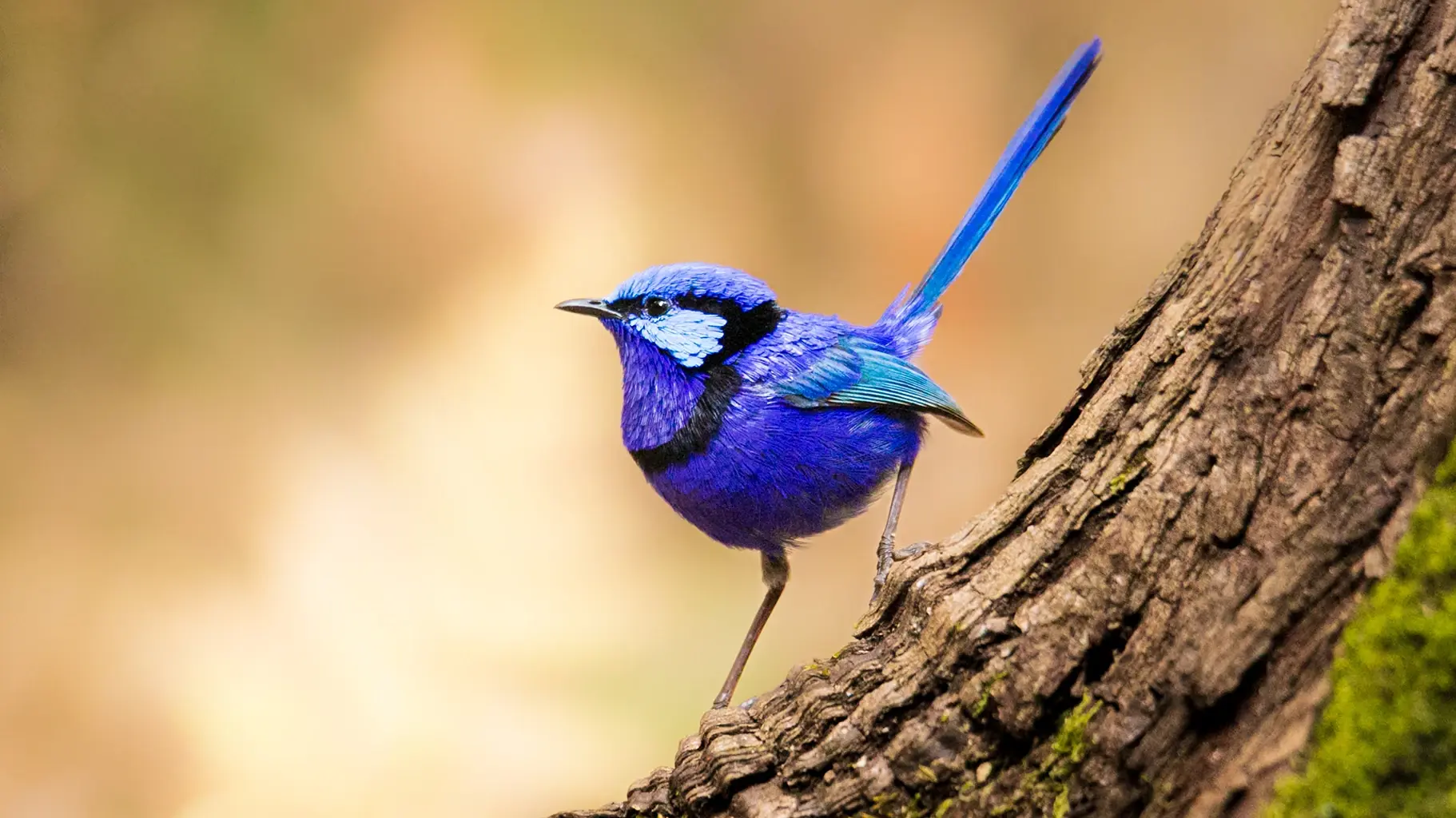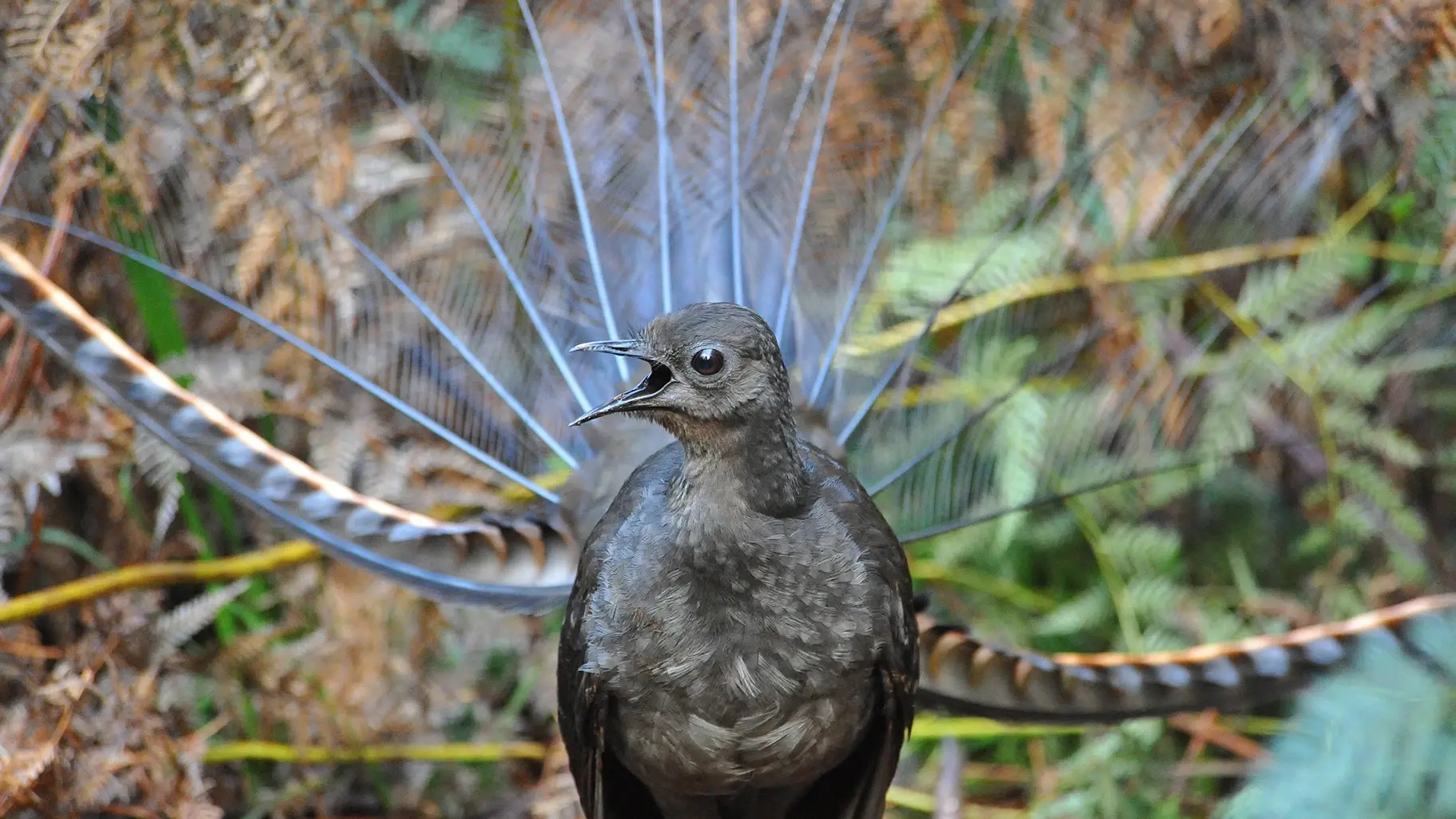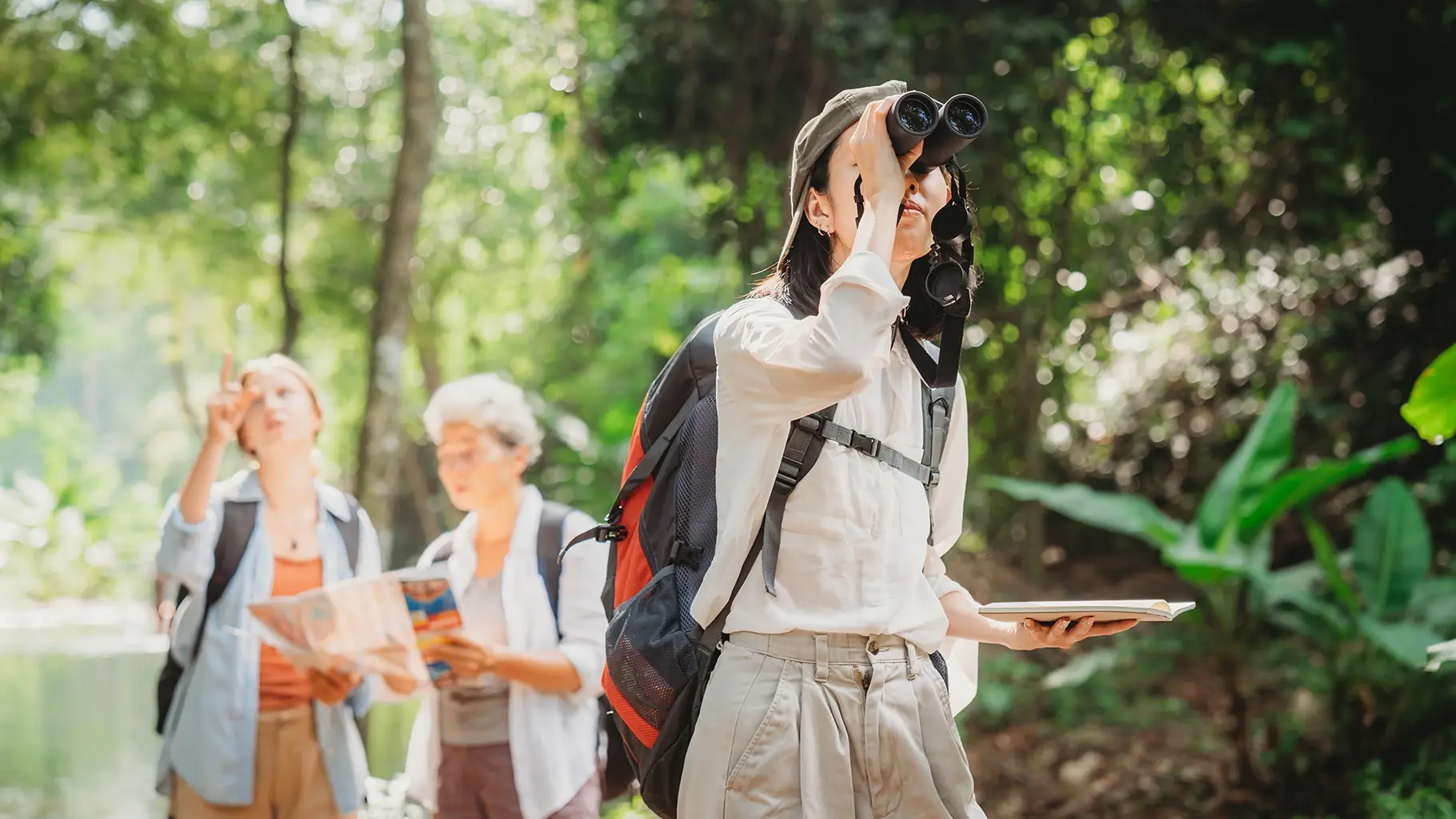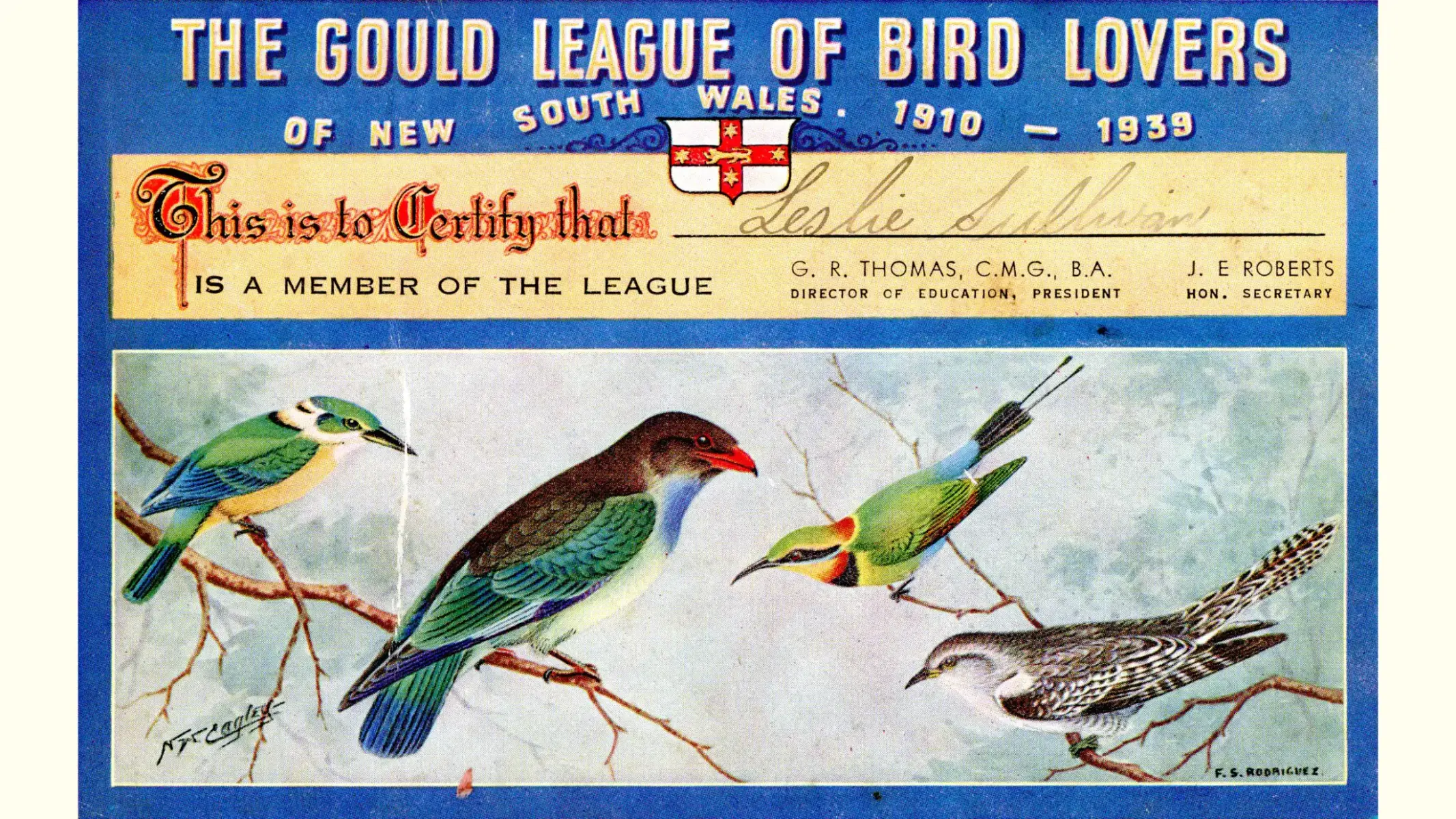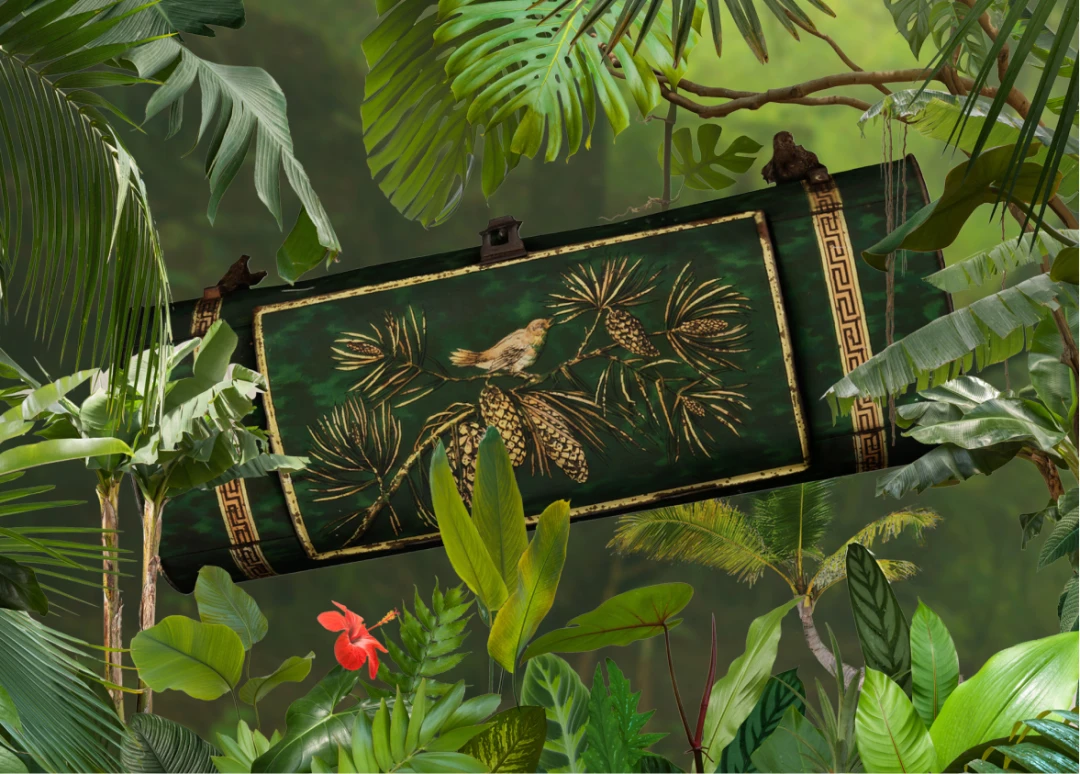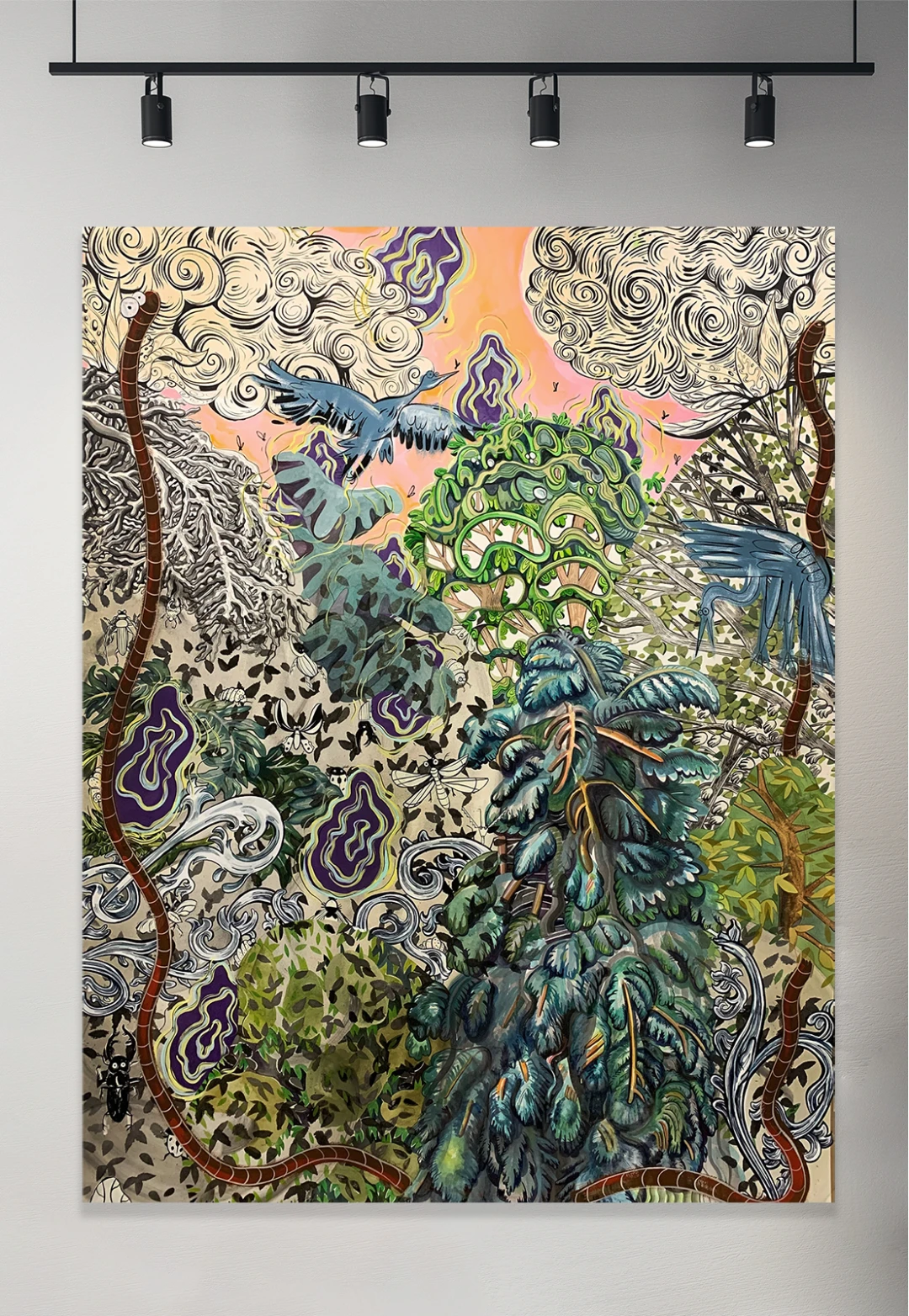The Gould League of Bird Lovers
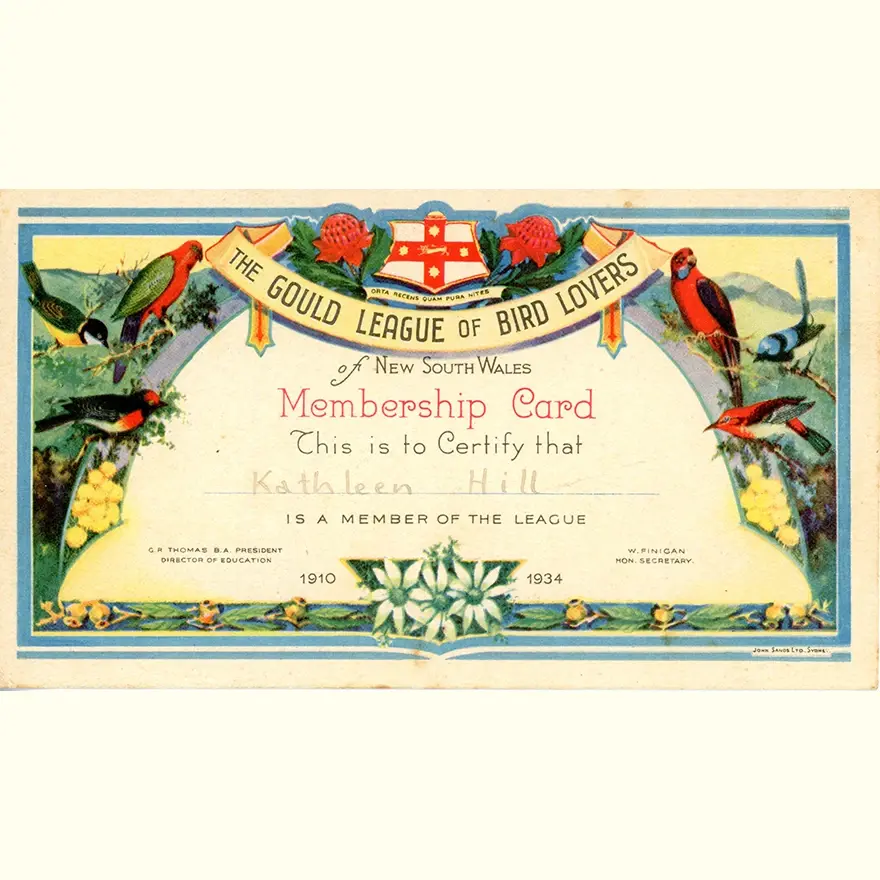
The Gould League was one of the first conservation groups in Australia to promote citizen science for the protection of birds.

The League taught people about birds and how to protect them. Members received certificates like the one you made!

The Gould League was one of the first conservation groups in Australia to promote citizen science for the protection of birds.
Gould League Certificates
Take action to protect animals
Today many groups, such as Birdlife and WWF, help protect birds and nature. The Gould Leagues were pioneers in teaching kids how to care for nature. In 1967 the League changed their name to ‘The Gould League’. This change reflected their new aim and pledge to protect all wildlife – birds, animals, and plants! What motivates you to protect birds and other animals?

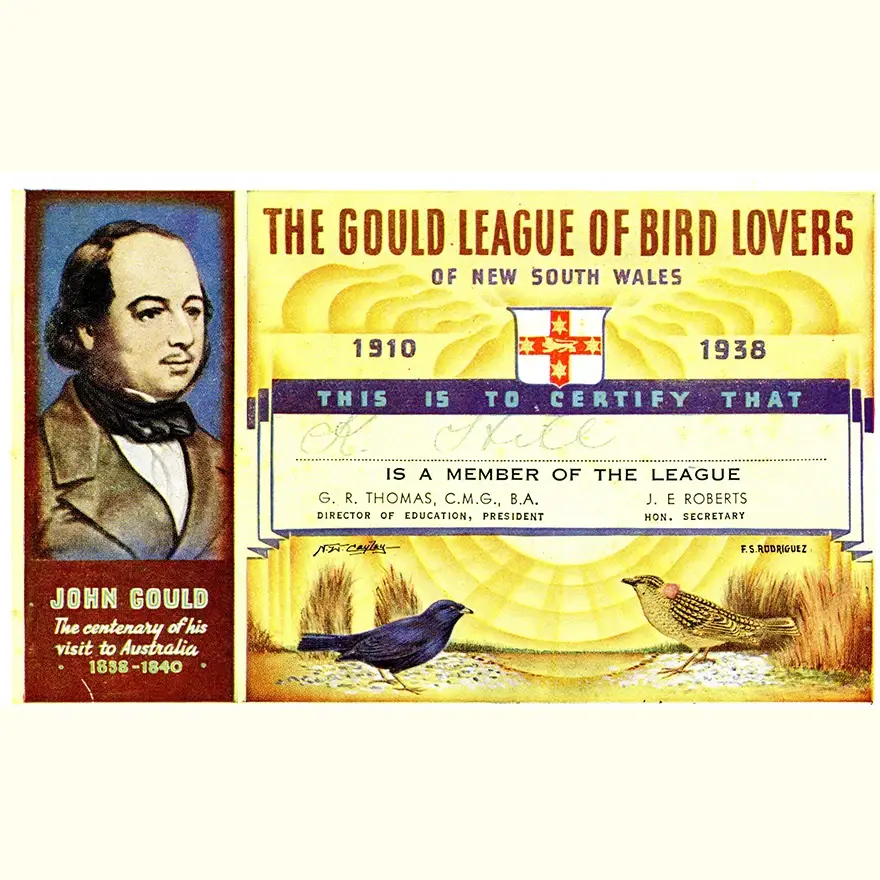
The Gould League was named after English naturalists John and Elizabeth Gould. The couple published beautifully illustrated and well-researched books about birds in the 1800s. Many scientists used their books to learn about birds all over the world.
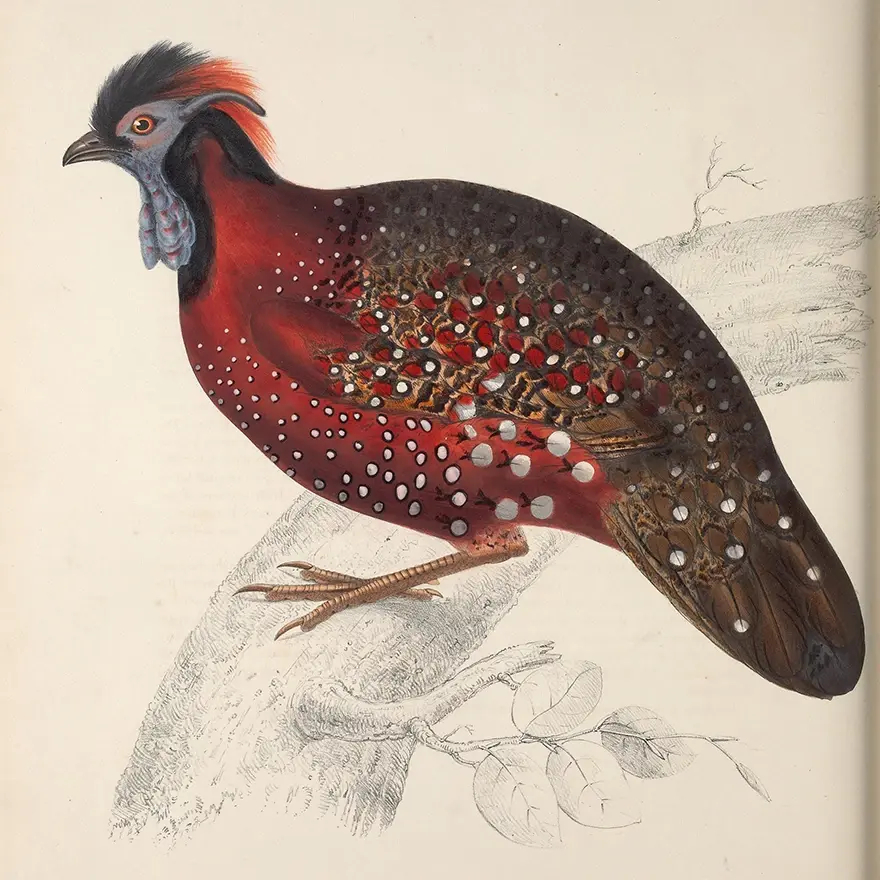
Today, many people remember John Gould for his beautiful bird illustrations. But it was often his wife, Elizabeth, who created them! John wasn’t an artist, but he was deeply involved in creating the illustrations, like the one of the horned pheasant above.
Conservation is everybody’s business!
The 1965 slogan of the Gould League of Bird Lovers
Birds, birds, everywhere!
Birds are unique! Like humans, birds are vertebrates. This means they have a backbone and an internal skeleton. Birds are also warm-blooded animals. All birds lay eggs, have wings and feathers, and most can fly. Another unique thing about birds is that they are widespread. You can find birds on every continent and in all kinds of ecosystems.
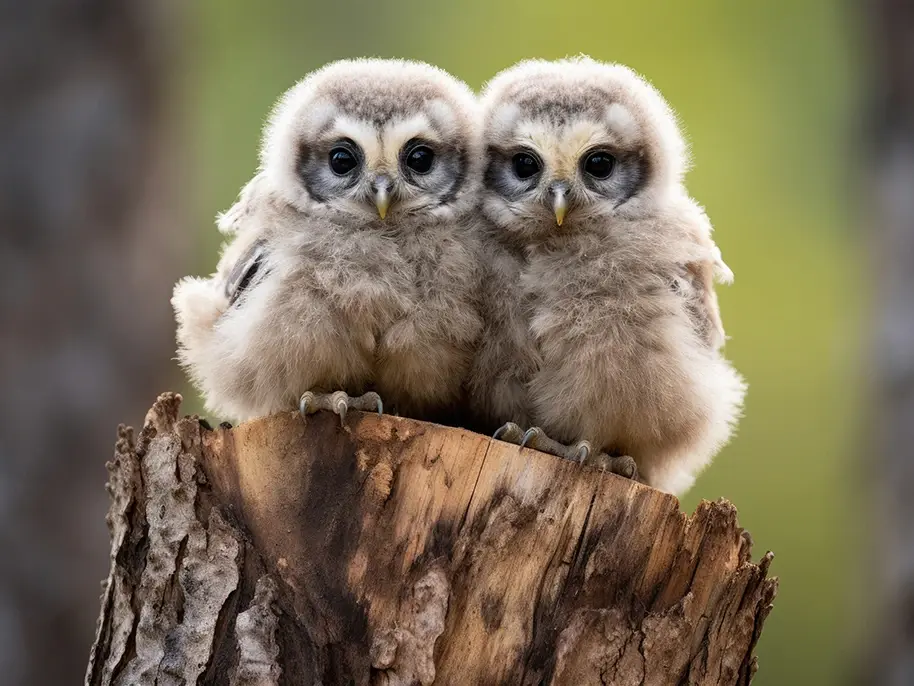
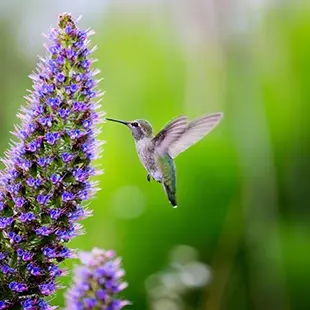
Pollinators and protectors
Did you know that bees and insects are not the only ones who pollinate plants? Birds are also important pollinators! Birds like hummingbirds and honeyeaters spread pollen when they drink nectar from flowers. Many birds also spread seeds in their droppings. Scientists have also discovered that bird droppings help keep ecosystems like coral reefs healthy.

Clean-up crews!
Birds help maintain the balance of ecosystems and keep populations in check. For example, many insects feed on plants. Without birds to keep their numbers down, these insects could eat and destroy entire ecosystems! Birds such as vultures also clean up carcasses quickly, which helps to prevent the spread of disease.
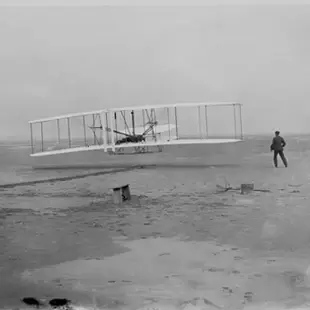
Inspired by nature
The incredible features of birds, their flight and feathers, have inspired many scientists and inventions including the first aircraft. The wings of the first airplane with a motor, designed by the Wright brothers, were inspired by studying the position and movements of birds’ wings during flight. Have you ever been inspired by birds or nature?
What do birds tell us about the health of our planet?
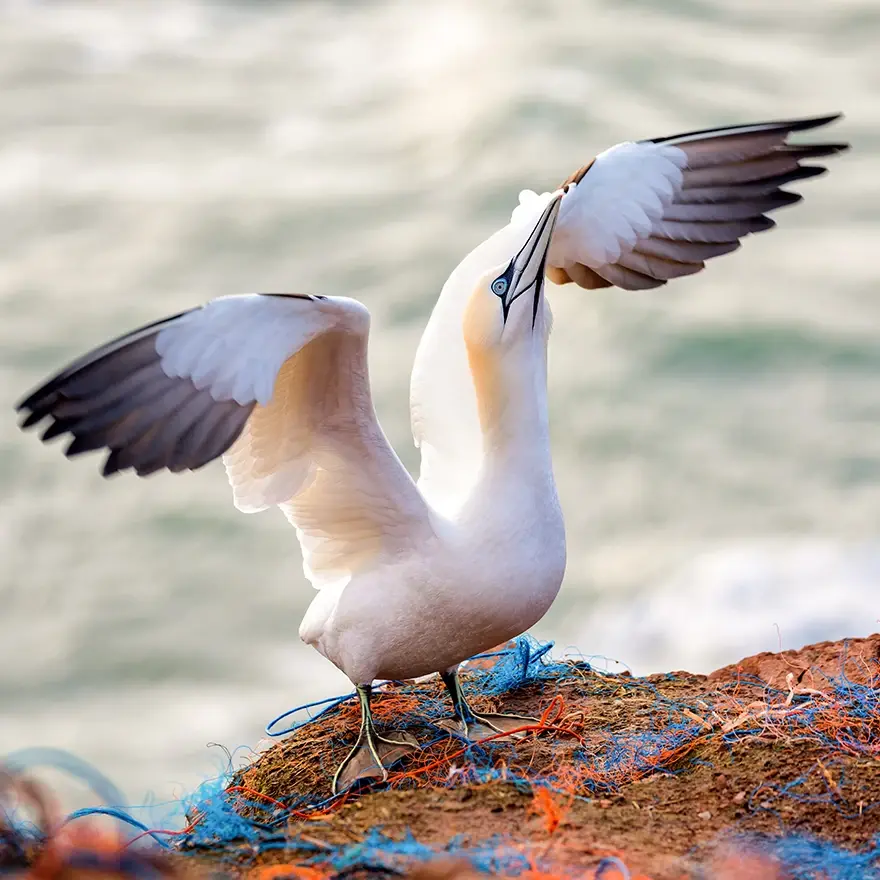
Did you know that birds can help us understand how the Earth is doing? Because they can fly, birds can often respond to changes in their ecosystem faster than other animals. For example, as the climate changes, birds change when and where they migrate.

By noticing changes in bird behavior, scientists can tell when an ecosystem is changing and why. This can help to understand the health of the planet. To do this, scientists need “bird data”. Citizen scientists help create a lot of the data they use.
Citizen scientists around the world help scientists understand and better protect birds and nature!
Are you a scientist?
Citizen scientists are everyday people who help to collect data. In the world of birds, as a citizen scientist, you can record data about what birds you see, when and where you see them, and how many there are. By sharing the data you collect, you can help scientists gain valuable research insights and learn how to best protect birds!
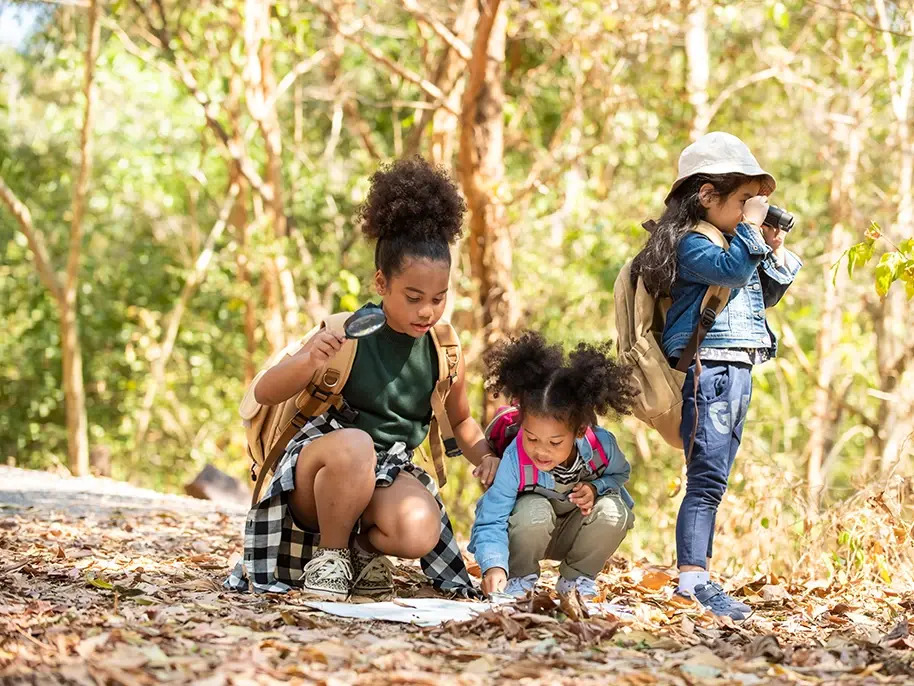
What’s next?
Today, citizen scientists around the world play a vital role in conservation science and efforts. There are many ways to get involved in these projects:
Take part in a bird count. In a bird count, citizen scientists identify and count the birds they see over a short period of time, then share their data. Bird counts help scientists better understand and protect birds!
Share your sightings using an app like eBird. eBird helps you to identify birds and to record and share images, video and audio of them with researchers. Every sighting helps conservationists make decisions about how to protect nature.
Get involved with a citizen science project in your area. A good place to learn about them is through organizations such as Birdlife, the World Wildlife Fund, or a local conservation organization near you.
Want to know more?
Bibliography
Citizen Science
BirdLife International. (2022, March 11). Anyone can be a citizen scientist! BirdLife International. https://www.birdlife.org/news/2022/03/11/anyone-can-be-a-citizen-scientist/
BirdLife International. (2022). State of the World’s Birds 2022: Insights and solutions for the biodiversity crisis. https://www.birdlife.org/papers-reports/state-of-the-worlds-birds-2022/.
Fraisl, D., Campbell, J., See, L. et al. (2020) Mapping citizen science contributions to the UN sustainable development goals. Sustain Sci 15, 1735–1751. https://doi.org/10.1007/s11625-020-00833-7
Sorenson, Graham. (2018, Nov. 7). Connecting regional Citizen Science projects with eBird. eBird Canada. https://ebird.org/canada/news/connecting-regional-citizen-science-projects-with-ebird
The Cornell Lab of Ornithology. (n.d.). Citizen Science for Educators. Cornell Lab of Ornithology, Cornell University. https://www.birds.cornell.edu/k12/citizen-science-for-educators
The Cornell Lab of Ornithology. (n.d.). Citizen Science. Cornell Lab of Ornithology, Cornell University. https://www.birds.cornell.edu/citizenscience
The Cornell Lab of Ornithology. (n.d.). Citizen Science: Be Part of Something Bigger. Cornell Lab of Ornithology, Cornell University. https://www.birds.cornell.edu/home/citizen-science-be-part-of-something-bigger/
The Cornell Lab of Ornithology, Bird Academy. (n.d.). Inspiring Investigations through Citizen Science. Cornell Lab of Ornithology, Cornell University. https://www.birds.cornell.edu/home/citizen-science-be-part-of-something-bigger/
The Cornell Lab of Ornithology. (n.d.). eBird. Cornell Lab of Ornithology, Cornell University. https://ebird.org/home
Bird Data and Science
BirdLife International. (2022). State of the World’s Birds 2022: Insights and solutions for the biodiversity crisis. https://www.birdlife.org/papers-reports/state-of-the-worlds-birds-2022/.
Callaghan, C. T., Nakagawa, S., & Cornwell, W. K. (2021). Global abundance estimates for 9,700 bird species. Proceedings of the National Academy of Sciences, 118(21). https://www.pnas.org/doi/full/10.1073/pnas.2023170118.
Main, Douglas. (2021, May 17). How many birds are there in the world? New research estimates that there are between 50 billion and 430 billion birds on Earth. National Geographic. https://www.nationalgeographic.com/animals/article/how-many-birds-are-there-in-the-world-science-estimates.
Southern Cassowary
eBird. (n.d.). Southern Cassowary. Casuarius casuarius. The Cornell Lab of Ornithology. eBird. https://ebird.org/species/soucas1
Eschner, Kat. (2017, Sep. 22). Five Fascinating Facts About the Amazing Cassowary. Smithsonian Magazine (online edition). https://www.smithsonianmag.com/smart-news/five-facts-cassowary-180964963/
Healy, Timothy P. (2022, July 15). Southern Cassowary. (Casuarius casuarius). Birds of the World, The Cornell Lab of Ornithology. https://doi.org/10.2173/bow.soucas1.02
Smithsonian’s National Zoo and Conservation Biology Institute. (n.d.) Southern Cassowary. https://nationalzoo.si.edu/animals/southern-cassowary
World Wildlife Magazine. (2021). Meet the cassowary, a bird with claws rivaling Freddy Krueger’s. https://www.worldwildlife.org/magazine/issues/fall-2021/articles/meet-the-cassowary-a-bird-with-claws-rivaling-freddy-krueger-s
Endemic Species
American Museum of Natural History. (n.d.). Endemic. Ology Card 339. American Museum of Natural History. https://www.amnh.org/explore/ology/ology-cards/339-endemic
Morrone, J.J. (2008). Endemism. Encyclopedia of Ecology. Vol. 3, p. 81-86. https://doi.org/10.1016/B978-0-444-63768-0.00786-1
Bird Characteristics
Gill, F. , Storer, . Robert W. and Rand, . Austin L. (2023, November 14). bird. Encyclopedia Britannica. https://www.britannica.com/animal/bird-animal
National Geographic. (2012). Birds Pictures and Facts. Animal Encyclopedia, National Geographic. https://www.nationalgeographic.com/animals/birds
U.S. Department of Agriculture. (n.d.). Bird Pollination. U.S. Forest Service, United States Department of Agriculture. https://www.fs.usda.gov/wildflowers/pollinators/animals/birds.shtml
Why are Birds Important?
Law, Jessica. (2019, Jan. 4). Why we need birds (far more than they need us). BirdLife International. https://www.birdlife.org/news/2019/01/04/why-we-need-birds-far-more-than-they-need-us/
Leffer, Lauren. (2021, Dec. 17). 6 Unexpected Ways Birds Are Important for the Environment (and People). Audobon Magazine. https://www.audubon.org/news/6-unexpected-ways-birds-are-important-environment-and-people
Missouri Department of Conservation. (n.d.). Why Should We Care About Birds? Missouri Department of Conservation. https://mdc.mo.gov/wildlife/birds-7/why-should-we-care-about-birds#:~:text=Birds%20Keep%20Our%20Ecosystems%20Running%20Smoothly&text=Birds%20eat%20400%E2%80%93500%20tons,as%20hummingbirds%20help%20pollinate%20plants.
Wright Brothers
Library of Congress. (n.d.). The Inventive Wright Brothers. Library of Congress, Classroom Materials. https://www.loc.gov/classroom-materials/inventive-wright-brothers/#:~:text=Lilienthal%27s%20study%20of%20the%20flight,and%20position%20of%20their%20wings.
Malsbury, Erin. (2020, Dec. 17). How We Lifted Flight from Bird Evolution. Smithsonian Voices, from the Smithsonian Museums. Smithsonian Magazine. https://www.smithsonianmag.com/blogs/national-museum-of-natural-history/2020/12/17/how-we-lifted-flight-bird-evolution/
National Air and Space Museum. (n.d.). 1903 Wright Flyer. The Estate of Orville Wright. National Air and Space Museum. https://airandspace.si.edu/collection-objects/1903-wright-flyer/nasm_A19610048000
Splendid Fairy Wren
eBird. (n.d.). Splendid Fairywren. Malurus splendens. The Cornell Lab of Ornithology. eBird. https://ebird.org/species/splfai1
John and Elizabeth Gould
Australian Museum. (n.d.). John and Elizabeth Gould. Australian Museum. https://australian.museum/publications/birds-storybox/john-elizabeth-gould/.
Australian Museum. (n.d.). John Gould: books and illustrations. Australian Museum. https://australian.museum/learn/collections/museum-archives-library/john-gould/.
Australian Museum. (n.d.). Elizabeth Gould (1804-1841). Australian Museum. https://australian.museum/learn/collections/museum-archives-library/john-gould/elizabeth-gould-1804-1841/.
Castellucci, Adria. (2022, July 12). Elizabeth Gould in Australia. Australian Museum. https://australian.museum/learn/collections/museum-archives-library/john-gould/elizabeth-gould-1804-1841/elizabeth-in-australia/.
Castellucci, Adria. (2022, July 12). Elizabeth Gould: working wife, Victorian mother. Australian Museum. https://australian.museum/learn/collections/museum-archives-library/john-gould/elizabeth-gould-1804-1841/working-wife-and-mother/.
Castellucci, Adria. (2022, July 12). John Gould’s documents of extinction. Australian Museum. https://australian.museum/learn/collections/museum-archives-library/john-gould/goulds-documents-of-extinction/.
Castellucci, Adria. (2022, July 12). The early art of Elizabeth Gould. Australian Museum. https://australian.museum/learn/collections/museum-archives-library/john-gould/elizabeth-gould-1804-1841/elizabeth-gould-early-art/.
Chisholm, A.H. (1979, 2006). Cayley, Neville William (1886-1950). Australian Dictionary of Biography, National Centre of Biography, Australian National University, https://adb.anu.edu.au/biography/cayley-neville-william-5540/text9439.
Chisholm, A.H. (1966, 2006). Gould, John (1804-1881). Australian Dictionary of Biography, National Centre of Biography, Australian National University, https://adb.anu.edu.au/biography/gould-john-2113/text2667.
Chisholm, A.H. (1979, 2006). Gould, Elizabeth (1804–1841). Australian Dictionary of Biography, National Centre of Biography, Australian National University, https://adb.anu.edu.au/biography/gould-elizabeth-2112/text2665.
Research Library. (2021, April 16). John Gould and his contribution to science. Australian Museum. https://australian.museum/learn/collections/museum-archives-library/john-gould/gould-and-his-contribution-to-science/.
Research Library. Stephens, Matthew. (2021, January 14). John Gould in Australia. Australian Museum. https://australian.museum/learn/collections/museum-archives-library/john-gould/gould-in-the-field/.
Research Library. Stephens, Matthew. (2021, February 12). John Gould the artist. Australian Museum. https://australian.museum/learn/collections/museum-archives-library/john-gould/gould-the-artist/.
Twyman, Anette. (2021, July 6). Birds of a Feather. National Portrait Gallery. https://www.portrait.gov.au/magazines/65/birds-of-a-feather.
The Gould Leagues
BIRD DAY. (1909, June 5). Geelong Advertiser (Vic. : 1859 - 1929), p. 3. http://nla.gov.au/nla.news-article150844091.
BIRD DAY. (1909, June 5). Geelong Advertiser (Vic. : 1859 - 1929), p. 3. http://nla.gov.au/nla.news-article150844091.
BIRD DAY. (1911, October 21). Leader (Melbourne, Vic. : 1862 - 1918, 1935), p. 28. http://nla.gov.au/nla.news-article198144411.
BIRD DAY. (1911, October 25). The Maitland Daily Mercury (NSW : 1894 - 1939), p. 2. http://nla.gov.au/nla.news-article121471225.
Cayley, Neville William. (1954). What bird is that? A guide to the birds of Australia. Angus & Robertson. https://www.biodiversitylibrary.org/item/251259#page/9/mode/1up.
Egg Collecting. (1936, January 4). Nepean Times (Penrith, NSW : 1882 - 1962), p. 5. http://nla.gov.au/nla.news-article101062709.
Kass, Dorothy. (2017). Gould League of Bird Lovers. Dictionary of Educational History in Australia and New Zealand (DEHANZ). https://dehanz.net.au/entries/gould-league-of-bird-lovers/.
NSW Schoolhouse Museum of Public Education. (n.d.). Gould League of Bird Lovers of New South Wales membership. NSW Schoolhouse Museum of Public Education. https://www.schoolhousemuseum.org.au/collection/collection-stories/gould-league-membership-cards/.
Victorian Collections. (2018, January 9). Victorians & Native Birds: An evolving relationship. Victorian Collections, https://victoriancollections.net.au/stories/victorians-native-birds-an-evolving-relationship.
Copyright and licenses
Bird images in digital asset
Cropped image of a Bar-Tailed Godwit. John Gould, Elizabeth Gould, Edward Lear, The Birds of Europe, IV, 1837. Plate 306. Original Image from Biodiversity Heritage Library. Contributed by Smithsonian Libraries. | www.biodiversitylibrary.org. Public Domain. (https://www.biodiversitylibrary.org/page/42174043)
Cropped image of an Arctic Tern. John Gould, Elizabeth Gould, Edward Lear, The Birds of Europe, V, 1837. Plate 419. Original Image from Biodiversity Heritage Library. Contributed by Smithsonian Libraries. | www.biodiversitylibrary.org. Public Domain. (https://www.biodiversitylibrary.org/page/42358579)
Cropped image of a Barn Swallow. John Gould, Elizabeth Gould, Edward Lear, The Birds of Europe, II, 1837. Plate 54. Original Image from Biodiversity Heritage Library. Contributed by Smithsonian Libraries. | www.biodiversitylibrary.org. Public Domain. (https://www.biodiversitylibrary.org/page/42173401)
Cropped image of a Peregrine Falcon. John Gould, Elizabeth Gould, Edward Lear, The Birds of Europe, I, 1837. Plate 21. Original Image from Biodiversity Heritage Library. Contributed by Smithsonian Libraries. | www.biodiversitylibrary.org. Public Domain. (https://www.biodiversitylibrary.org/page/42174323)
Cropped image of a Common Kingfisher. John Gould, Elizabeth Gould, Edward Lear, The Birds of Europe, II, 1837. Plate 61. Original Image from Biodiversity Heritage Library. Contributed by Smithsonian Libraries. | www.biodiversitylibrary.org. Public Domain. (https://www.biodiversitylibrary.org/page/42173375)
Cropped image of a Northern Lapwing. John Gould, Elizabeth Gould, Edward Lear, The Birds of Europe, IV, 1837. Plate 291. Original Image from Biodiversity Heritage Library. Contributed by Smithsonian Libraries. | www.biodiversitylibrary.org. Public Domain. (https://www.biodiversitylibrary.org/page/42173983)
Cropped image of a Northern Shoveler. John Gould, Elizabeth Gould, Edward Lear, The Birds of Europe, V, 1837. Plate 360. Original Image from Biodiversity Heritage Library. Contributed by Smithsonian Libraries. | www.biodiversitylibrary.org. Public Domain. (https://www.biodiversitylibrary.org/page/42358344)
Cropped image of a Great White Egret. John Gould, Elizabeth Gould, Edward Lear, The Birds of Europe, IV, 1837. Plate 276. Original Image from Biodiversity Heritage Library. Contributed by Smithsonian Libraries. | www.biodiversitylibrary.org. Public Domain. (https://www.biodiversitylibrary.org/page/42173923)
Cropped image of a Barn Owl. John Gould, Elizabeth Gould, Edward Lear, The Birds of Europe, I, 1837. Plate 36. Original Image from Biodiversity Heritage Library. Contributed by Smithsonian Libraries. | www.biodiversitylibrary.org. Public Domain. (https://www.biodiversitylibrary.org/page/42174383)
Cropped image of a Superb Lyrebird. John Gould, Elizabeth Gould, Henry Constantine Richter, The Birds of Australia, III, 1848. Plate 14. Original Image from Biodiversity Heritage Library. Contributed by Smithsonian Libraries. | www.biodiversitylibrary.org. Public Domain. (https://www.biodiversitylibrary.org/page/48285735)
Bird sounds
Arctic Tern - Sterna paradisaea, Lars Edenius, CC BY-NC-SA 4.0
Barn Swallow - Hirundo rustica, Lars Edenius, CC BY-NC-SA 4.0
Bar-tailed Godwit - Limosa lapponica, Lars Edenius CC BY-NC-SA 4.0
Common Kingfisher - Alcedo atthis, Recordfield Concept, CC BY-NC-SA 4.0
Great Egret - Ardea alba, Marco Dragonetti, CC BY-NC-SA 4.0
Northern Lapwing - Vanellus vanellus, Oliver SWIFT, CC BY-NC-SA 4.0
Northern Shoveler - Spatula clypeata, Simon Elliott, CC BY-NC-SA 4.0
Peregrine Falcon - Falco peregrinus, Lars Edenius, CC BY-NC-SA 4.0
Superb Lyrebird - Menura novaehollandiae, Vicki Powys, CC BY-NC-SA 4.0
XC771408 - Western Barn Owl - Tyto alba, Dominique Guillerme, CC BY-NC-SA 4.0
Images in quiz
Northern Lapwing Display Behaviour by creativenature.nl via Adobe Stock.
A superb lyrebird, Menura novaehollandiae, Victoria, Australia by Rixie via Adobe Stock.
Magnificent Barn Owl perched on a stump in the forest (Tyto alba) by Monikasurzin via Adobe Stock.
Great white egret landing by Jérôme Bouche via Adobe Stock.

